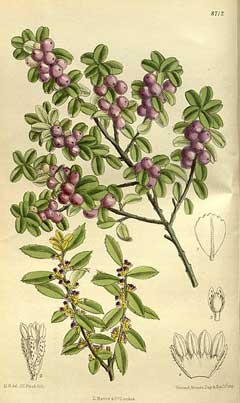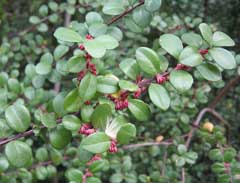 |
|
http://commons.wikimedia.org/wiki/File:Myrsine_africana_143-8712.jpg |
 |
| http://commons.wikimedia.org/wiki/User:Cillas |
Translate this page:
Summary
Physical Characteristics

 Myrsine africana is an evergreen Shrub growing to 0.8 m (2ft 7in) by 0.8 m (2ft 7in) at a slow rate.
Myrsine africana is an evergreen Shrub growing to 0.8 m (2ft 7in) by 0.8 m (2ft 7in) at a slow rate.
See above for USDA hardiness. It is hardy to UK zone 9. It is in leaf all year, in flower in May. The species is dioecious (individual flowers are either male or female, but only one sex is to be found on any one plant so both male and female plants must be grown if seed is required). . The plant is not self-fertile.
Suitable for: light (sandy), medium (loamy) and heavy (clay) soils and prefers well-drained soil. Suitable pH: mildly acid, neutral and basic (mildly alkaline) soils. It can grow in semi-shade (light woodland) or no shade. It prefers moist soil.
UK Hardiness Map
US Hardiness Map
Synonyms
M. retusa.
Plant Habitats
Woodland Garden Sunny Edge; Dappled Shade; Hedge;
Edible Uses
Edible Parts: Fruit
Edible Uses: Condiment
Fruit[105, 177]. The fruit is about 6mm in diameter and contains a single seed[200]. Two other reports say that the fruit is used as an anthelmintic[146, 158]. The seed is used as an adulterant of pepper[177].
References More on Edible Uses
Medicinal Uses
Plants For A Future can not take any responsibility for any adverse effects from the use of plants. Always seek advice from a professional before using a plant medicinally.
Anthelmintic Blood purifier Emmenagogue Laxative
The fruit is used as an anthelmintic, especially in the treatment of tape worm[146, 158, 240]. It is also laxative and is used in the treatment of dropsy and colic[240]. The fruit contains 3% embelic acid and 1% quercitol, the seed contains 4.8% embelic acid and 1% quercitol[240]. These are the active ingredients that work as an anthelmintic[240]. A gum obtained from the plant is used as a warming remedy in the treatment of dysmenorrhoea[240]. A decoction of the leaf is used as a blood purifier[240].
References More on Medicinal Uses
The Bookshop: Edible Plant Books
Our Latest books on Perennial Plants For Food Forests and Permaculture Gardens in paperback or digital formats.

Edible Tropical Plants
Food Forest Plants for Hotter Conditions: 250+ Plants For Tropical Food Forests & Permaculture Gardens.
More

Edible Temperate Plants
Plants for Your Food Forest: 500 Plants for Temperate Food Forests & Permaculture Gardens.
More

More Books
PFAF have eight books available in paperback and digital formats. Browse the shop for more information.
Shop Now
Other Uses
Hedge Hedge Wood
Plants are used for hedging in warm temperate zones[200]. The plant is used in technology[145]. This report gives no more details, we assume that it refers to the wood being used.
Special Uses
Hedge Hedge Scented Plants
References More on Other Uses
Cultivation details
Succeeds in any well-drained fertile circum-neutral soil in full sun or semi-shade[200]. Dislikes shallow chalky soils[188]. Requires a sunny position according to another report[182]. This species only succeeds outdoors in the milder areas of the country[182]. Plants can tolerate several degrees of short-lived frost if they are growing in a well drained soil in a position sheltered from drying winds[200]. Plants are very slow-growing[188]. The leaves are aromatic[182]. Dioecious, male and female plants must be grown if seed is required[182].
References Carbon Farming Information and Carbon Sequestration Information
Temperature Converter
Type a value in the Celsius field to convert the value to Fahrenheit:
Fahrenheit:
The PFAF Bookshop
Plants For A Future have a number of books available in paperback and digital form. Book titles include Edible Plants, Edible Perennials, Edible Trees,Edible Shrubs, Woodland Gardening, and Temperate Food Forest Plants. Our new book is Food Forest Plants For Hotter Conditions (Tropical and Sub-Tropical).
Shop Now
Plant Propagation
Seed - sow late winter or early spring in a warm greenhouse. When they are large enough to handle, prick the seedlings out into individual pots and grow them on in a semi-shaded position in the greenhouse for at least their first winter[78]. Plant them out into their permanent positions in late spring or early summer, after the last expected frosts. Cuttings of half-ripe wood, 3 - 6cm long with a heel in individual pots, July/August in a frame. Good percentage[78].
Other Names
If available other names are mentioned here
Native Range
TEMPERATE ASIA: Yemen, Afghanistan, China (Gansu Sheng, Guangxi Zhuangzu Zizhiqu, Guizhou Sheng, Hubei Sheng, Hunan Sheng, Shaanxi Sheng, Sichuan Sheng, Xizang Zizhiqu, Yunnan Sheng) TROPICAL ASIA: India, Pakistan AFRICA: Portugal (Azores), Ethiopia, Somalia, Kenya, Tanzania, Angola, Mozambique, Malawi, Zambia, Zimbabwe, Namibia
Weed Potential
Right plant wrong place. We are currently updating this section.
Please note that a plant may be invasive in one area but may not in your area so it's worth checking.
Conservation Status
IUCN Red List of Threatened Plants Status :

Growth: S = slow M = medium F = fast. Soil: L = light (sandy) M = medium H = heavy (clay). pH: A = acid N = neutral B = basic (alkaline). Shade: F = full shade S = semi-shade N = no shade. Moisture: D = dry M = Moist We = wet Wa = water.
Now available:
Food Forest Plants for Mediterranean Conditions
350+ Perennial Plants For Mediterranean and Drier Food Forests and Permaculture Gardens.
[Paperback and eBook]
This is the third in Plants For A Future's series of plant guides for food forests tailored to
specific climate zones. Following volumes on temperate and tropical ecosystems, this book focuses
on species suited to Mediterranean conditions—regions with hot, dry summers and cool, wet winters,
often facing the added challenge of climate change.
Read More
Expert comment
Author
L.
Botanical References
1150200
Links / References
For a list of references used on this page please go here
Readers comment